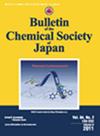金属卤化物过氧化物光伏材料化学
IF 3.8
3区 化学
Q2 CHEMISTRY, MULTIDISCIPLINARY
引用次数: 0
摘要
金属卤化物包晶体半导体是下一代太阳能电池的绝佳材料。经过全世界的研究和开发,单电池器件的光电转换效率已迅速提高到 26% 以上(截至 2023 年 7 月),而硅-过氧化物串联器件的效率目前达到创纪录的 33.7%(2023 年 5 月报道)。材料化学为取得这些令人瞩目的成果做出了许多重要贡献。在本报告中,我们将介绍材料化学研究在这些领域取得的成就,包括高纯度前驱体材料的开发和为大面积印刷包晶薄膜量身定制的前驱体油墨,以提高包晶光伏器件的性能。通过对成核和结晶过程的研究(包括模拟),可靠地制造出了高质量的包晶体薄膜。各种新型电荷收集材料以及有效修饰过氧化物表面的化合物提高了太阳能电池的性能。本文章由计算机程序翻译,如有差异,请以英文原文为准。
Materials Chemistry for Metal Halide Perovskite Photovoltaics
Metal halide perovskite semiconductors are excellent materials for next-generation solar cells. As a result of research and development all over the world, the photoelectric conversion efficiency for single-cell devices has rapidly improved to over 26% (as of July 2023), while the record efficiency for silicon-on-perovskite tandem devices currently stands at 33.7% (reported in May 2023). Materials chemistry has made many important contributions toward these remarkable results. In this account, we will introduce our achievements in these areas of material chemistry research for improving the performance of perovskite photovoltaics, including the development of high-purity precursor materials, and precursor inks tailored for large-area printed perovskite films. Studies of the nucleation and crystallization process, including simulations, have led to the reliable fabrication of high-quality perovskite films. Diverse new charge collection materials, as well as compounds to effectively modify the perovskite surfaces, have improved solar cell performance.
求助全文
通过发布文献求助,成功后即可免费获取论文全文。
去求助
来源期刊
CiteScore
6.40
自引率
5.00%
发文量
194
审稿时长
3-8 weeks
期刊介绍:
The Bulletin of the Chemical Society of Japan (BCSJ) is devoted to the publication of scientific research papers in the fields of Theoretical and Physical Chemistry, Analytical and Inorganic Chemistry, Organic and Biological Chemistry, and Applied and Materials Chemistry. BCSJ appears as a monthly journal online and in advance with three kinds of papers (Accounts, Articles, and Short Articles) describing original research. The purpose of BCSJ is to select and publish the most important papers with the broadest significance to the chemistry community in general. The Chemical Society of Japan hopes all visitors will notice the usefulness of our journal and the abundance of topics, and welcomes more submissions from scientists all over the world.

 求助内容:
求助内容: 应助结果提醒方式:
应助结果提醒方式:


